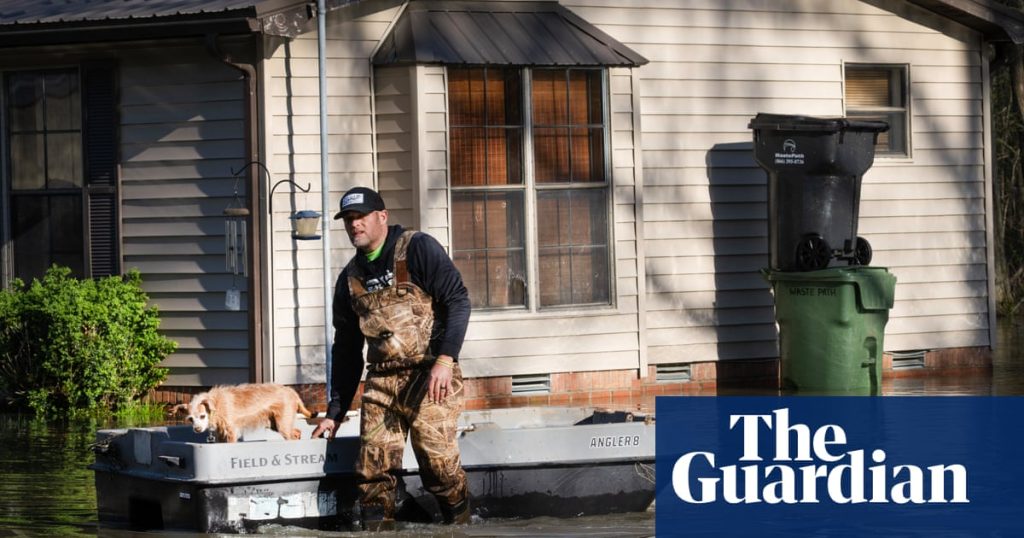The four-day historic storm that caused death and destruction across the central Mississippi valley in early April was made significantly more likely and more severe by burning fossil fuels, rapid analysis by a coalition of leading climate scientists has found.
Record quantities of rain were dumped across eight southern and midwestern states between 3 and 6 April, causing widespread catastrophic flooding that killed at least 15 people, inundated crops, wrecked homes, swept away vehicles and caused power outages for hundreds of thousands of households.
The floods were caused by rainfall made about 9% more intense and 40% more likely by human-caused climate change, the World Weather Attribution (WWA) study found. Uncertainty in models means the role of the climate crisis was probably even higher.
Another nine people died as a result of tornadoes and strong winds, and the economic damages have been estimated to be between $80bn and $90bn.
The record rainfall was driven in large part by warm ocean temperatures in the Gulf of Mexico that fed the storm moisture that it dropped across Mississippi, Arkansas, Missouri, Illinois, Indiana, Kentucky, Tennessee and Alabama. Overall, the human-caused climate crisis made surface sea temperatures 2.2F (1.2C) hotter, and such ocean conditions are now 14 times more likely compared with in a cooler, pre-industrial world, the study found.
The region has been pummeled by multiple deadly storms over recent years including Hurricane Helene in September that killed more than 230 people mostly from heavy rainfall and flooding.
But last month’s death toll could have been much worse – if it had not been for the around-the-clock forecasting and early warnings by the National Weather Service (NWS), which is facing major cuts and staff layoffs thanks to Donald Trump and his billionaire donor Elon Musk, according to the study authors.
Overall, the NWS issued 728 different severe thunderstorm and tornado warnings – the third-highest number on record – that helped local authorities issue timely evacuations orders and position emergency resources that saved lives.
“These floods didn’t make front pages, but they should have. At least 15 people died, homes were ruined and farmland turned into swamps,” said Friederike Otto, senior lecturer in climate science at Imperial College London’s Grantham Institute – Climate Change and the Environment. “In an increasingly dangerous world of extreme weather, a well-resourced forecasting workforce is essential. The recent layoffs at the National Weather Service workers will put lives at risk.”
A combination of weather patterns, including the collision of two air masses, created a storm that lingered and subjected the region to days of apocalyptic weather including hundreds of tornadoes, hailstorms, landslides and wind events. Based on historical data, similar downpours are expected to occur on average about once a century in today’s climate with 2.3F of heating above pre-industrial levels.
Yet things are on track to get much worse. If the transition from oil, gas and coal to renewable energy sources continues at today’s snail pace, four-day spells of rainfall will be twice as likely and 7% more intense by 2100, the study found.
The planet’s most important stories. Get all the week’s environment news – the good, the bad and the essential
Privacy Notice: Newsletters may contain info about charities, online ads, and content funded by outside parties. For more information see our Privacy Policy. We use Google reCaptcha to protect our website and the Google Privacy Policy and Terms of Service apply.
after newsletter promotion
The NWS is among key federal agencies under assault by the Trump administration that research, prepare for and respond to extreme weather events, which were already overwhelmed due to the climate crisis.
Nearly half of NWS offices have 20% vacancy rates – double the level of short-staffing compared with 10 years ago. Amid mass layoffs and buyouts, there is no chief meteorologist at 30 of the 122 NWS local offices including several in Kentucky, Ohio and Tennessee where the storm struck, according to CNN.
Trump’s climate-related cuts come on top of policies to boost fossil fuels and block renewables, as the US braces itself for another year of destructive wildfires, extreme temperatures and Atlantic storms.
“We’re dealing with floods, droughts, wildfires and heatwaves – many times all at once – and science keeps confirming they’re getting more dangerous as the planet heats up,” said Shel Winkley, weather and climate engagement specialist at Climate Central. “Understanding precisely where and when these unnatural extreme events will strike is vital for protecting public safety.”
This is the 101st WWA study, a decade-old initiative that provides rapid scientific analysis on whether and to what extent human-induced global heating driven by burning fossil fuels and deforestation has altered the likelihood and intensity of a local extreme weather event. The latest study was conducted by 15 researchers as part of the World Weather Attribution group, including scientists from universities and meteorological agencies in the US, UK, France and Netherlands.

